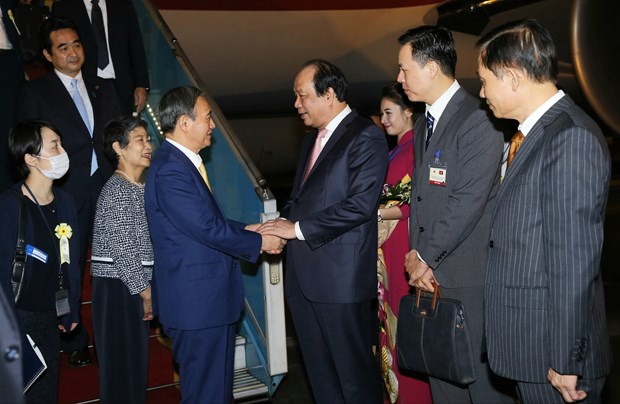Japanese PM Yoshihide Suga begins Viet Nam visit
Japanese Prime Minister Yoshihide Suga and his wife started their official visit to Viet Nam from 18 October afternoon at the invitation of Prime Minister Nguyen Xuan Phuc.
 |
| Japanese Prime Minister Yoshihide Suga arrives in Ha Noi on 18 October, begining his official visit to Viet Nam. (Photo: VNA) |
This is his first overseas trip by PM Suga since he took office last month and the second consecutive time that a Japanese prime minister has selected Vietnam as his first overseas destination after taking office.
After Viet Nam and Japan established diplomatic ties on 21 September, 1973, the bilateral relationship has experienced rapid developments over the past years.
The Viet Nam-Japan relationship is now at its best since the establishment of the diplomatic ties, with high mutual trust.
The two sides have maintained important cooperation mechanisms such as the Viet Nam-Japan Cooperation Committee co-chaired by foreign ministers of the two countries, the strategic partnership dialogue on external affairs, national defence and security at deputy foreign ministerial level, the defence policy dialogue at the deputy ministerial level, the deputy ministerial-level security dialogue, the joint committee on trade, energy and industry, the agricultural dialogue at the ministerial level, and the maritime policy dialogue at the ministerial level.
Japan is Viet Nam’s leading important economic partner, the largest official development assistance (ODA) provider, second biggest investor, third largest tourism partner and fourth largest trade partner.
In the first nine months of this year, two-way trade revenue reached 28.6 billion USD. By September 2020, Japan had run 4,595 valid FDI projects worth 59.87 billion USD in Vietnam, ranking second among 136 countries and territories investing in the Southeast Asian nation.
Meanwhile, Japan’s ODA to Viet Nam was valued at some 2.57 trillion JPY (23.76 billion USD) as of December 2019, making up 26.3 percent of Viet Nam’s accumulative foreign loans.
Breakthrough have been made in agricultural cooperation between the two countries since the State visit to Japan by President Sang in 2014, as reflected through the signing of a medium and long-term vision on agricultural cooperation in September 2015, and the signing of an adjusted vision in May 2018.
Notably, collaboration in climate change response has made big strides as Japan has continuously provided ODA for Viet Nam in recent years to help the latter roll out projects in this regard.
Partnerships in education and training have also flourished in different forms. Currently, Viet Nam is the largest source of trainees in Japan with the total number exceeding 230,000.
Japan is one of the countries that have granted the largest non-refundable aid to Viet Nam’s education and training sector. More than 80,000 Vietnamese students are studying in the country.
Japan is cooperating with four Vietnamese universities to improve their training quality, while helping Viet Nam with high-quality personnel training in science, technology, management and services, and Japanese language teaching.
Relations between localities of the two countries are also thriving, with more than 70 cooperation documents inked so far.
Amidst the COVID-19 pandemic, the two countries have maintained all-level exchanges in different forms. PM Phuc held phone talks with PM Suga on 12 October, and with PM Abe on 4 May and 4 August.
Meanwhile, Deputy Prime Minister and Foreign Minister Pham Binh Minh had phone talks with Japanese Foreign Minister Motegi Toshimitsu in March and June.
The two countries have also supported each other in the fight against the epidemic.
The Japanese leader’s visit would offer an opportunity for Viet Nam to prove its safety and effective response to the COVID-19 pandemic, while promoting the country’s achievements in reform and socio-economic development, as well as efforts in improving its position in international area, implementing the foreign policy and international integration.
Source: VNA